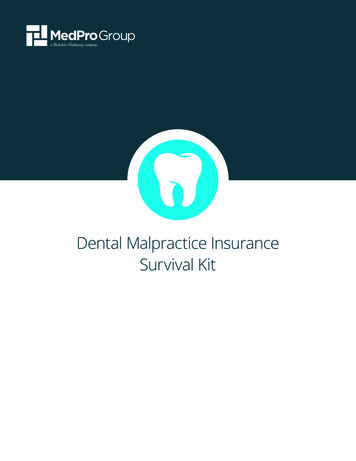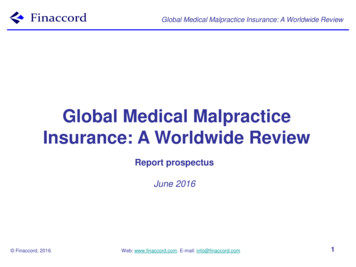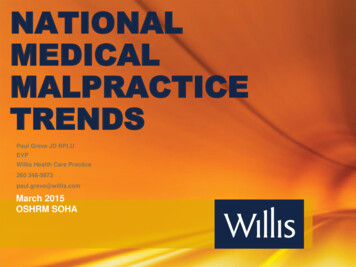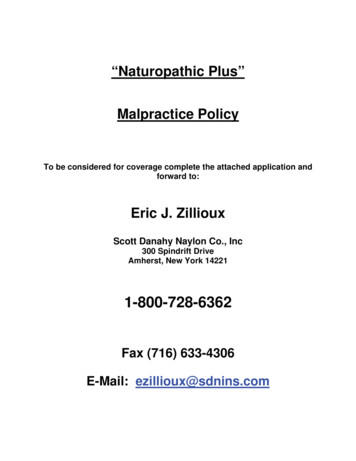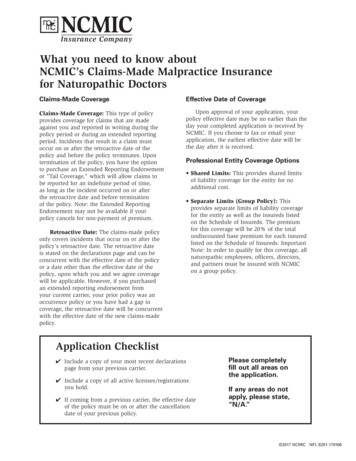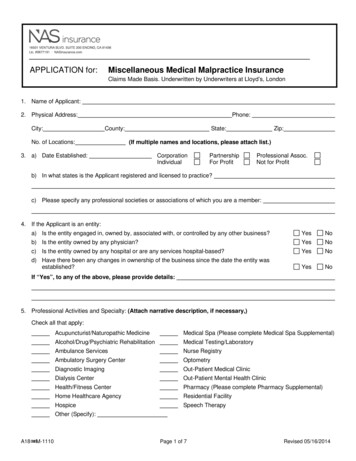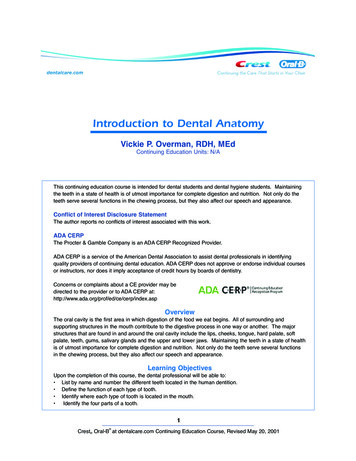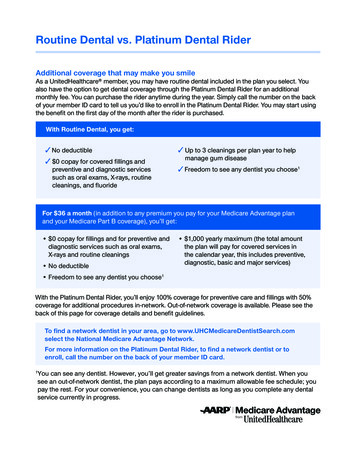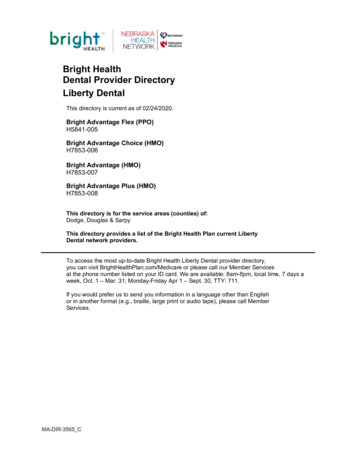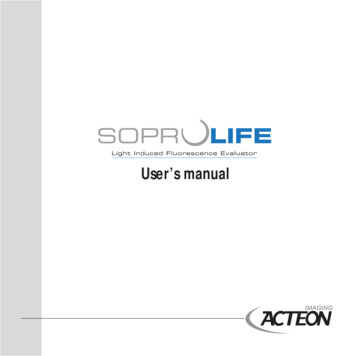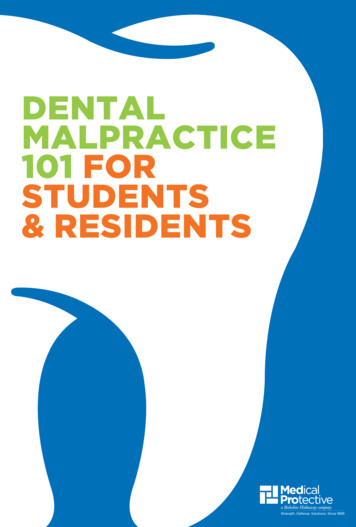
Transcription
DENTALMALPRACTICE101 FORSTUDENTS& RESIDENTS
THIS HANDBOOK IS DESIGNED TOprovide facts, insights, educational websites,resources, and tools that will help youselect a dental malpractice company and aninsurance policy.NTRIT IS IMPORTANT TO REMEMBER thatselecting an insurance company and amalpractice insurance policy are personaldecisions.You invest an immense amountof time and money earning your dentallicense; Medical Protective wants to makesure you’re educated and prepared to makedecisions regarding the best ways to protectyour license, as well as your reputation andassets.TO PUT THINGS IN PERSPECTIVE,let’s take a look at one of your potentialcolleagues, Dr. Stacy.FROM CHILDHOOD, STACY HAD KNOWNTHAT SHE WANTED TO BE A DENTIST.She worked hard to achieve this dream and graduated with honors fromdental school. Everyone agreed she was one of the best and brightest students.After graduation, Stacy had three job offers and her whole life ahead of her.Stacy joined a prestigious practice and was successful in a short period oftime. She married, bought a house, and was thoroughly enjoying life.Three years later, Stacy received notice that a lawsuit was being filed againsther for services she had provided during her first year of practice. Herpsyche and confidence were shaken, and she was unsure of how to proceed.Unfortunately, Stacy had never taken the time to read her malpracticeinsurance policy in any detail. She really hadn’t understood many of the terms,such as “claims-made coverage,” “policy limits,” and “consent to settle.” Asmany young dentists do, Stacy had allowed someone else – her former officemanager – to select her malpractice insurance. Now she had no way ofknowing whether or not this decision left her with sufficient coverage orquality claims defense necessary to protect her during the case.This scenario is not uncommon. A recent Medical Protective study indicatesthat 64% of all first-time dental malpractice insurance buyers allow others toeither recommend or decide from which malpractice insurance company theyshould purchase their insurance.1 New-to-practice dentists may be poorlyinformed about insurance issues; as a result, they may feel more comfortableleaving such an important decision in the hands of others. However, somelater regret the choice in malpractice companies or insurance policies —usually at the time a claim is made or when the insurance company exits themarket.This handbook will outline the critical factors to consider when choosingmalpractice insurance. It will also introduce you to Medical Protective andour expertise in professional liability coverage (malpractice insurance).1. Medical Protective internal dental malpractice data, 201364%of all first-time dental malpracticeinsurance buyers allow others toeither recommend or decide fromwhich malpractice insurance companythey should purchase their insurance.
CONTENTS01SECTION ONEUnderstanding DentalMalpractice Insurance03SECTION TWOUnderstanding DentalMalpractice Policies11SECTION THREEUnderstanding RiskManagement and ClaimsDefense16SECTION FOURSelecting the RightMalpractice InsuranceCompany for You19SECTION FIVEWho is MedicalProtective?24SECTION SIXTools & Resources31APPLICATIONSUnderstandingDental MalpracticeInsurance
SECTION 1: UNDERSTANDING DENTAL MALPRACTICE INSURANCEWHAT IS MALPRACTICE?Merriam-Webster defines malpractice as “a dereliction of professional duty or failureto exercise an ordinary degree of professional skill or learning by one renderingprofessional services which results in injury, loss, or damage.”In more basic terms, dental malpractice refers to a deviation from the standard of carethat results in patient injury or death due to negligent treatment or failure to diagnoseand/or treat. If it can be proved that a dentist acted negligently to cause a patient injury,the patient may be able to recover damages through the civil litigation process tocompensate for his or her harm.WHAT IS MALPRACTICE INSURANCE?A malpractice (professional liability) insurance policy typically provides for both defensecosts when a malpractice case is brought forward and indemnification for any damagesdeemed payable to the plaintiff.WHY DO I NEED MALPRACTICE INSURANCE?Many dentists who have not been involved in a lawsuit think, “This won’t happen to me”or “Only bad dentists get sued.” Unfortunately, each year, about 8,500 of your futurecolleagues are named as defendants in malpractice lawsuits.2 Although the likelihood ofbeing involved in a lawsuit can increase or decrease based on practice location, the typeof practice, and the procedures you perform, this averages to approximately one claim ina typical dentist’s career.The National Practitioner Data Bank (NPDB) indicates that the average dentalmalpractice payout is about 68,000. This number is limited to the actual indemnitypayment to a plaintiff; it does not include defense costs, which can be greater than thatsame amount when defending a claim in a malpractice trial.221. How many dentists are namedin a malpractice lawsuit eachyear?3a) 1,500b) 3,000c) 8,500d) 10,0002. What is the approximateaverage payout in dentalmalpractice cases?a) 10,000b) 35,000c) 50,000d) 68,000ANSWERS: 1. C 2. DQUIZA lawsuit is not necessarily the tool that measures “good” or “bad” dentistry, but theend result of a malpractice claim can be traumatic, time-consuming, and expensive —regardless of the final verdict.National Practitioner Data Bank Public Use File, December 2012. 3 Estimated based on the number of reported claims to the NPDB.UnderstandingDental MalpracticePolicies
SECTION 2: UNDERSTANDING DENTAL MALPRACTICE POLICIESWHEN IT COMES TO MALPRACTICE INSURANCE,YOU HAVE TWO DIFFERENTCOVERAGE OPTIONS: OCCURRENCE OR CLAIMS-MADE.The major difference between the two types of coverage is whether coverage istriggered based on when an incident occurs or when an actual claim is filed.OCCURRENCE COVERAGEOccurrence coverage is triggered the moment dental treatment occurs, regardless ofwhen an eventual claim is filed.ExampleIf a claim is filed in 2014 based on treatment rendered in 2012, the 2012occurrence policy responds.Benefits of Occurrence Coverage Coverage is provided for treatment rendered while the policy is in effectregardless of when the policy period is over. A separate set of policy limits is available every year you have occurrencecoverage. This means policy limits stay in place year after year, even after theend of the policy period. There is no reason to purchase “tail coverage” (see below). When factoring the cost of tail coverage, occurrence policies are often lessexpensive than claims-made policies.CLAIMS-MADE COVERAGEClaims-made coverage is triggered when the claim is filed. This means that a policy mustbe in effect when the claim is filed.ExampleIf a claim is filed in 2014 based on treatment rendered in 2012, the 2014 claimsmade policy will respond as long as the treatment occurred after the policy’sretroactive date.Benefits of Claims-Made Coverage Initially, claims-made policies are less expensive than occurrence policies.TAIL COVERAGE?Because claims-made coverage is triggeredwhen a claim is filed, these policies do not coverclaims filed after the termination or cancellationof the policy. To extend coverage aftertermination or cancellation of a claims-madepolicy, you will need to secure an extendedreporting endorsement (called tail coverage) oryour new insurance company must cover yourprior acts.Many dentists who purchase claims-madecoverage assume that they will someday qualifyfor free tail coverage. However, each year morethan 50% of tail coverage that is issued atMedical Protective is purchased, not free.4COMMON CIRCUMSTANCES THATREQUIRE THE PURCHASE OF A TAIL:Board CoverageAs you approach your board exams, you willlikely have coverage offered to you at no costfor your board exam. If this policy is not anoccurrence policy, you will need to secure tailcoverage after the termination of your boardexam coverage (to cover any exposures duringyour board exam). Not having tail coveragemeans not being protected if a claim is filedafter the policy period expires!Externships & MoonlightingWhen entering these great learningopportunities, remember that coverage typematters. After you have completed yourexternship or stopped moonlighting, you mayneed to pay for tail coverage if you’ve obtained aclaims-made policy during this period.FYITAIL COVERAGE ISGENERALLY VERYEXPENSIVE.In fact, depending on thestate, tail coverage can cost140–220% of your current,undiscounted annual claimsmade premium. Paymentfor tail coverage is typicallydue in full and must be paidwithin 30–60 days of policycancellation.SOME COMPANIES WILLOFFER TAIL COVERAGEAT NO CHARGE in theevent of death, permanentdisability, or, in some cases,at retirement. Look for thequestions to ask regardingclaims-made policies and tailcoverage in the “ComparingMalpractice InsuranceCompanies” section onpage 17.ResidencyIf you decide to return to school for a residencyprogram, you will likely be covered by theuniversity. If so, you could cancel any coverageyou have for your current practice. However, ifyou are insured under a claims-made policy, youwill have to purchase tail coverage to cover anyyears spent in practice.44Medical Protective internal data, 2013.5
SECTION 2: UNDERSTANDING DENTAL MALPRACTICE POLICIESLeave of AbsenceYou may want to terminate coverage while taking a leave of absence from practice. Ifyou are insured under a claims-made policy, it may require the purchase of tail coverage.Examples of a leave of absence include maternity leave, poor health, a sabbatical, andmedical mission trips.RelocationIf you move to a state where your insurance company does not offer coverage or wherethe cost of malpractice insurance is significantly lower than the original state, you mayneed to purchase tail coverage from your current insurance company.Non-RenewalIf your insurer does not renew your policy, and if that policy was a claims-madepolicy, you may need to purchase a tail policy to maintain coverage for all proceduresperformed during the claims-made coverage.MobilityAn increasing number of new graduates are joining dental franchises. Statistics haveshown the policies provided are often claims-made. The average length of employmentwith these organizations is 1.5 to 2 years.You may be required buy tail coverage whenyou leave the franchise, unless your new employer commits to pay for tail coverage inyour employment contract or another insurance company covers your prior acts.FacultyMore dentists and dental specialists are deciding to work in a faculty setting prior toretirement. What if you leave private practice to work for a university? In order toensure coverage for procedures performed during your time spent in private practice,you must purchase tail coverage if you were insured under a claims-made policy.MALPRACTICE 101state, you may have a required minimum limit of liability. Check with your personalattorney prior to deciding on policy limits.HOW DOES THE TYPE OF COVERAGE AFFECT THE POLICY LIMITS I PURCHASEEVERY YEAR?Policy limits dictate the maximum amount of money your insurance company will payon your behalf. How a policy’s limits of liability respond to claims is one of the majordistinctions between occurrence and claims-made coverage. The difference betweenoccurrence and claims-made policy limits becomes even more relevant once the claimsmade coverage is terminated and tail coverage is purchased or earned.OccurrenceOccurrence coverage provides a separate set of limits for each year you buythe policy, with respect to alleged errors occurring during the policy period,regardless of when a claim is made against you. Occurrence coverage doesn’tend when the policy terminates; instead, the limits under the policy remainavailable to pay future claims based upon incidents that occurred during thatpolicy period.Claims-madeContrast this with claims-made coverage, which only provides limits for claimsmade during the current policy year, so only the current set of limits is availableto pay claims arising from all your previous years of practice. For a claims-madepolicy that offers a standard 1 million/ 3 million policy limit, only 1 million isavailable to pay any single claim, and only 3 million total to pay all claims arisingduring the span of the policy period.KEY TAKEAWAYIf you want to eliminate the above-listedcomplexities involving tail coverage, you maywant to purchase an occurrence policy.POLICY LIMITSPolicy limits are written as two numbers, such as 1 million/ 3 million. The first number, 1 million, reflects what the insurance company will pay per claim/occurrence. Thesecond number, 3 million, is the aggregate limit for the policy year.There is no universal agreement on how much malpractice insurance coverage issufficient, so most insurance companies currently provide a variety of policy limitsranging from 100,000 to 5 million per claim (“per claim limit”). Depending on your6ExampleOver the course of a 35-year career, a general dentist will treat approximately129,000 patients, presenting 129,000 opportunities for a patient to allege7
SECTION 2: UNDERSTANDING DENTAL MALPRACTICE POLICIESmalpractice. With tail coverage, a single set of limits covers the dentist’s careerback to the retroactive date. This means the dentist will have only one set oflimits (for example, 1 million/ 3 million) to pay all potential malpractice claimsthat are made during the extended reporting period (based on all the incidentsthat occurred over an entire 35-year career).In contrast, if the same dentist had purchased occurrence coverage each yearfor the same 35-year period, he or she would have 35 separate sets of limitsover the same time span — one for each policy year.With regard to tail coverage, limits may differ according to the policy provisions. Insome instances, the tail coverage (or extended reporting period) will have limits thatare reinstated and equal to those limits in effect during the most recent policy period.In other instances, the limits of liability are not reinstated for the extended reportingperiod; instead, the tail coverage actually shares the limits of liability from the mostrecent policy period.As another example, some carriers may set the limits of liability for your extendedreporting period to the lowest limits you had during any of your last five policy periods.Be sure to review your policy for the limits of liability available for tail coverage.WHAT IS A PATIENT’S COMPENSATION FUND, AND HOW DOES A STATEMANDATED CAP ON DAMAGES AFFECT POLICY LIMITS?A number of states have established a Patient’s Compensation Fund (PCF), which isdesigned to increase availability and/or affordability of professional liability insurance.Of those states, Indiana and Louisiana have unique policy limit options for dentistsparticipating in the PCF.IndianaIn Indiana, your malpractice insurance company and the PCF work together.Dentists in Indiana are insured by a malpractice insurance company for 250,000 per claim/occurrence and 750,000 in the aggregate limit. If youparticipate in the PCF, you also receive an additional 1 million per claim/occurrence from the PCF. Your malpractice insurance company will submit yourPCF surcharge to the Indiana PCF.LouisianaIn Louisiana, your malpractice insurance company and the PCF work together.Dentists in Louisiana purchase malpractice insurance with a 100,000 perclaim/occurrence limit and 300,000 aggregate limit of liability from aninsurance company. If a claim arises with damages above these amounts, thePCF will provide excess coverage up to 400,000, plus medical expenses.Yourmalpractice insurance company will submit your PCF surcharge to the LouisianaPCF.8MALPRACTICE 101Policy LimitsIndiana 250,000/ 750,000Louisiana 100,000/ 300,000Fund Limits 1 million/ 3 million 400,000ARE THERE ANY OTHER STATES WITH LIMIT REQUIREMENTS?Many other states require minimum limits of liability for dentists. In some states,minimum limits are not required, but maximum damages caps are set. For example, inVirginia, the cap for malpractice damages for dentists is 2.15 million per claim as of2013. The cap is adjusted annually by 50,000 until the total cap reaches 3 million.Most dentists in Virginia select a limit of liability equal or greater than the cap ofdamages. Check with your personal attorney before choosing a limit of liability.CONSENT TO SETTLEYour policy sets forth the rights, duties, and obligations of both the insurer and theinsured with regard to settlement of a claim. This part of the policy is typically calledthe “consent to settle provision.” You will typically find your consent to settle provisionembedded in your malpractice policy’s language.Marketing material or “company philosophy” may state you have rights, but you shouldinvestigate the actual policy language to determine if you have a pure consent to settleclause. A pure consent to settle provision will require the insurance company to obtainyour approval before settling any claim. There are no exceptions and no strings attached.Instead of a pure consent to settle provision, you may find exceptions that give allauthority regarding settlement back to the insurance company.COMMON EXCEPTIONS TO CONSENT TO SETTLEMENT1Hammer ClauseIf you refuse to consent to a settlement and elect to contest orcontinue to contest a claim, the company’s liability for loss shall notexceed the amount for which they could have settled such claim hadyou consented, plus claim expenses incurred prior to the time thecompany made such recommendation.23UnreasonableYou have consent authority, unless the insurance company deems youunreasonable in withholding your consent.4Binding ArbitrationYou have consent authority unless the company disagrees, at whichtime they submit your refusal to consent to binding arbitration.Board ApprovalYou have consent authority as long as the company’s review panel orboard agrees with you that your performance met the standard ofcare. If they disagree, the board assumes consent authority on yourbehalf.9
SECTION 2: UNDERSTANDING DENTAL MALPRACTICE POLICIES5678No Longer Insured by the CompanyYou have consent authority unless you are no longer insured by thecompany at the time settlement or trial occurs.Unavailable or Cannot Be LocatedYou have consent authority unless the company cannot locate you oryou are otherwise unavailable at the time of settlement or jury trial.License SuspendedYou have consent authority unless your professional license has beensuspended, revoked, or surrendered at any time during the claimprocess.Deceased or IncompetentYou have consent authority unless you are deceased or deemedincompetent.Make sure you understand how your insurance company defines consent. If any of theabove conditions or exceptions are present, your policy does not have a pure consent tosettle provision.ENTITY COVERAGE (COVERING YOUR PRACTICE)It is important to know that, just like you, your practice can be named in a malpracticelawsuit. If you are planning on owning a practice, you should consider two importantcoverage options: separate limits and shared limits.Separate Limits CoverageIf you own all or a portion of your practice, your practice may be eligible for anentity malpractice insurance policy with separate limits of liability. This allowsdefense costs and indemnity payments to be paid on behalf of your practice —separately from your individual policy limits.Shared Limits CoverageIf you have a solo corporation or a single-dentist practice, own 100% of yourpractice, and have no employed or contracted dentists, then you may request toshare your individual policy limits with your practice. This means defense costsand indemnity payments will be paid on behalf of both you and your practiceunder one shared set of limits.?DID YOU KNOWClaims-made policies increase in price eachyear for the first 5 years until the rate is“mature,” after which the annual prem
malpractice insurance. It will also introduce you to Medical Protective and our expertise in professional liability coverage (malpractice insurance). 64% of all first-time dental malpractice insurance buyers allow others to either recommend or decide from which malpractice File Size: 1MB
